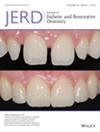An interdisciplinary treatment to reshape upper anterior displaced teeth by using dynamic occlusal recording with an intraoral scanner
Abstract
Objective
This article describes an interdisciplinary treatment that helped a patient with displaced upper anterior teeth. A gingivectomy, root canal therapies, digital smile design, digital wax-up, and guided tooth preparations were applied.
Clinical Considerations
A patient with pathologically migrated teeth asked for treatment without orthodontic involvement due to a primary failed orthodontic treatment history. A smile photo was taken and superimposed with the dentition in a CAD software to accomplish a digital smile design. The jaw movements were recorded with two different methods, a mechanical articulator and an intraoral scanner with Patient-Specific-Motion function. The occlusal contacts during protrusive and lateral movements were compared and the digital wax-up was designed according to the later occlusal data. An aesthetic crown lengthening and pre-op root canal treatment were carried out in advance accordingly. After guided tooth preparation with a silicone index, the final fixed restorations were manufactured and cemented. A 2-year follow-up showed that our prosthesis functions well.
Conclusions
This clinical report revealed that an intraoral scanner with Patient-Specific-Motion function can effectively record individual dynamic occlusal patterns and these data can be integrated into the CAD/CAM process to enhance the fulfillment of clinical requirements.
Clinical Significance
This clinical procedure with a 2-year follow-up demonstrated that a prosthodontic-based interdisciplinary treatment of pathologically migrated teeth using dynamic occlusal recording with an intraoral scanner could achieve satisfactory esthetics in a relatively short treatment period. The Patient Specific Motion module may be used to record a personalized functional movement and the data can be integrated into the design process of the final restorations.

 求助内容:
求助内容: 应助结果提醒方式:
应助结果提醒方式:


